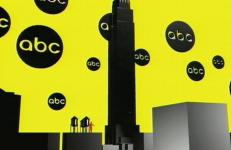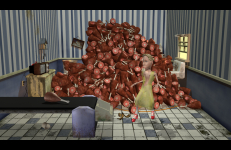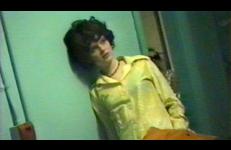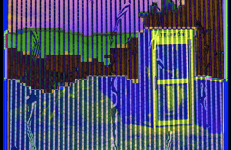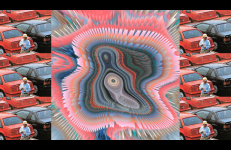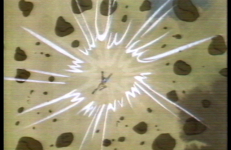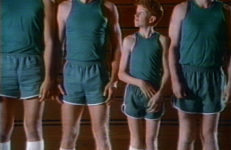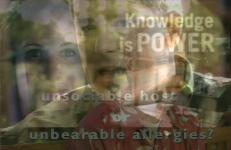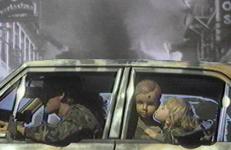An examination of venture capital, Nothing Ventured documents the tough negotiations that take place when entrepreneurs and bankers meet.
Consumer culture
Take a joyride through comfortable suburbia—a landscape molded by seductive television and corporate America (and keep in mind: disaster is another logo for your consumption...). This is the age of the "culture jammed" consumer preened with Friends hair, Survivor courage, and CNN awareness. A generation emptying their wallets for the most important corporate product of all: lifestyle. The psychological road trip across a slightly battered America travels at One Mile per Minute.
Oral Fixations is a single channel video installation that evolves over a seven hour time period. The project is a darkly humorous look at a habit of endless consumption and the resulting accumulation of waste. A narrative gradually emerges from the on-screen action that depicts a large mouthed character who dances while flossing its one protruding tooth. A conveyor belt regularly delivers factory-farm fresh hams that the character delights in taking one large bite from and then tossing aside.
A high and low fidelity record of obsessions past and present. A hooded man named Cobra Commander (drawn naked) and a boy with black glasses. A fanged woman named Shadow-La and a girl in a rose colored wig. Belinda (Heaven on Earth), Madonna (Live to Tell), and headphones (worn naked). An airport terminal. Home. The Montgomery Ward catalog circa 1980. That orange bedspread, that red flowered couch.
People enjoy my company connects the privatisation of telecommunications with techno-optimism, euphoria and online communication in the lead-up to the millennium.
The film explores the privatisation of the Irish state-owned telecommunications company Telecom Éireann from the viewpoint of shareholders communicating on early online forums. The event is contextualised within ideologies of technological emancipation in the pre-millennium period.
A Perfect Pair posits the idea that individual consumers are walking billboards for the products they use; product slogans and brand names peeking out from every crevice and cranny of the actors’ bodies. Export demonstrates how the body of the consumer, especially that of the female consumer, is co-opted by commercialism. In tongue-in-cheek fashion, A Perfect Pair celebrates the modern-day co-mingling of fetish objects, as a body builder seduces a prostitute at a bar saying, “Your eyes are the most beautiful blue ad-space. Your cheek could promote a Mercedes.
Petrolia takes its name from a redundant oil-drilling platform set in the Cromarty Firth, Scotland. The film looks at the architecture of the oil industry along the Scottish coastline where oil and gas supplies are predicted to run dry in the next forty years.
Broken up into "chapters," Phosphoresence features an array of abstractions created by manipulating television images. At times almost painterly, the resulting images are set to an ambient electronic soundtrack.
This title is also available on Anthony Discenza Videoworks: Volume 1.
A close-range look at pigs living on a farm in Las Vegas, Nevada. The pigs, individually and as a group, become a metaphor for humanity as they go from leisurely wallowing in the mud to the wildness of a feeding frenzy. In a key shot, a pig confronts the viewer with a prolonged, enigmatic stare, as if questioning the very nature of human/animal relationship.
“Marvelously abstract and perfectly concrete.”
-- The Jury of the 2011 Hong Kong International Film Festival
Via Jonathan Pryce in elaborate costuming, Walt Disney’s Pirates of the Caribbean (2003) unwittingly sounded a clear and full-throated argument for the appropriation of so-called intellectual property, for the video remix/rework/quotation, practices and forms that would become ubiquitous on YouTube and its ilk a few short years later.
Bracketed by the Fall of Berlin Wall and the Collapse of the World Trade Center, a decade that saw the ossification of the neoliberal project, the rise of third-wave feminism, the proliferation of digital media, and even, perhaps, the “end of history": postmodernism; the emergence of internet; the commercialization of gangsta rap, and independent film; AIDS activist; digital cinema, the Gulf War; rave and riot grrrl cultures; reality television; MTV. A new diagrammatic system.
Appropriating material from the introduction to the nightly television show, PM Magazine and a commercial for Wang Computers, Birnbaum uses enlarged still-frames from each of the sources to compound a new image of the indelible American Dream. To the soundtrack of an acid rock version of The Doors' L.A. Woman, repetitive images of an ice skater, baton twirler, cheerleader, and young girls licking ice cream, exemplify dominant cultural images of women — images that emphasize their performative nature: the idea that woman is a spectacle arranged for the (male) viewer's pleasure.
A man explains global currency markets without the help of his formerly trusty rockin’ talkin’ pony, who is missing. Without the pony, the world is as disorientating as it is depressing. The audience is invited to help make order of the chaos.
This title is also available on Ben Coonley: Post Pony Trilogy.
Possibly In Michigan is an operatic fairytale about cannibalism in Middle America. A masked man stalks a woman through a shopping mall and follows her home. In the end, their roles are reversed when the heroine deposits a mysterious Hefty bag at the curb. Like Condit's other video narratives, Possibly In Michigan shows bizarre events disrupting mundane lives. Combining the commonplace with the macabre, humor with the absurd, she constructs a world of divided reality.
In Precious Products we are subtly reminded of this country’s obsession with consumerism and narcissism. George, with his ever-present video-8 camera, attends an opening of Precious Products—an exhibition of artworks satirizing art as commodity. He leaves the art world of San Francisco to spend a Christmas holiday with friends in their opulent home. Ironically, this is the home of a celebrity (another kind of commodity), Russian defector/ballerina Natalia Makanova. Surrounded by all the luxuries of life and Makanova’s image, George muses about death.
Prime Time is a video collage of violent imagery appropriated from American commercial network television. The work features rapid-fire editing (i.e., for analog 3/4" video technology) often used by network producers to create a sense of action or tension, and violence from all genres of television programming – cartoons, news broadcasts, commercials, made-for-TV movies – is juxtaposed to create humorous effects and absurd situations.
Production Notes allows us to eavesdrop on the business decisions behind the creation of our daily diet of television commercials. This excellent tape undertakes to explode the address of seven TV ads by means of repetition, slow motion, and “production notes”— memos sent from the advertising agency to the production company prior to filming the spots, to describe the intentions, desires, strategies and ideology of the commercials and their creators.
pulse pharma phantasm is a frame by frame weaving of nine different pharmaceutical television commercials into a pulsating hallucination of worry and relief.
Using footage from a trip to the Orient, images of objects, products, the city and nature, Rankin investigates society's reverance for the "exotic" and the "pure" as manifested in tourism, Communism, Coca-Cola, Las Vegas, the Civil War, Hollywood, and photography. Examining the common idealisation of things distant in time or space, The Pure didactically reflects upon our societal penchant for categorization that begins with childhood games and is reflected in the way our culture organizes itself and the world around it.
RECKONING 3 is the first in a series of investigations into:
1. Terror and wonder in big-budget virtual worlds
2. The mutability, fragility and loneliness of technologically mediated social identities and friendships
3. The queerness and malevolence of archetypal masculinity
4. The diminishing distance between "real" and "artificial" humanity
5. The poetics of blockbuster aesthetics
RECKONING 4 is the second in a series of investigations into (among other things)
In a piece commissioned by Remy Martin, Birnbaum adopts the language of commercial advertising, using the body, gestures, and glances of a heavily made-up woman to create a scene of glamour and romance—while slipping in a disparaging narrative that touches on the actual use and abuse of Remy Martin's product. Birnbaum sets up a typical commercial, then allows the fictive narrative to intrude, upsetting the advertised fantasy with a dose of unpleasant reality.
Scenes from the Micro-War explains, "The worst of times—riots, famine, war—could be just around the next corner and, in the battle to survive, this family is going to be battle-ready from here on in." This fractured narrative follows the misadventures of a family hypnotized by Reagan’s Space Wars, state terrorism, and Rambo/commando fashions, as the family has shifts from consumerist unit to military training force.
Scenes from the Micro-War explains, "The worst of times—riots, famine, war—could be just around the next corner and, in the battle to survive, this family is going to be battle-ready from here on in." This fractured narrative follows the misadventures of a family hypnotized by Reagan’s Space Wars, state terrorism, and Rambo/commando fashions, as the family has shifts from consumerist unit to military training force.
Re-mastered in 2005, Reel 2 features a series of demonstrations and durational tests: how to protect oneself from germs; how to turn a roll call into a role play; and an excruciating exercise in desire, as Man Ray attempts to get his just rewards. While entertaining, these humorous pieces also parody television culture and work to highlight issues of consumerism.
Contents:
Sanforized, 0:47
Coin Toss, 2:11
Monkey Business, 1:06
Same Shirt, 0:32





